Newsletter 2009 Summer
Sotheby’s New York (April 22, 2009) The Princess Gorchakov Fabergé silver toilet set did not sell. Sotheby’s introduced an e-catalogue searchable by medium, estimate or artist, and other features for its Russian sales, and reduced the size of the print catalog to 6½ inches square.
Christie’s London (April 24, 2009) A Fabergé lily of the valley sold for $314,500. ‘Christie’s said there was competitive bidding from a diverse international client base. But purchases fell far short of recent years when billionaires splurged abroad to bring Russian art back home.’ Reuters News Service, April 25, 2009.
Jackson’s International Auctioneers, Cedar Falls, Iowa (June 23-24, 2009) sold a Fabergé clock for $72,000.
November 2009 Sotheby’s in London to Sell a Lost Inheritance of the Romanovs
Previously unknown and private collection of about 100 lots – cigarette boxes and an extraordinary array of cufflinks, including many fine pieces of Fabergé. Objects have ciphers, Imperial inscriptions and coats of arms, and even photographs of the Grand Ducal Vladimirs and their immediate family.
(Updates are posted in Exhibitions on the Fabergé Research Site)

Amstelhof, a monumental classical-style building facing the Amstel River in Amsterdam served as a retirement home for seniors beginning in 1692, and in 2004 it became an outpost of the Hermitage Museum. On June 19, 2009, Queen Beatrix of the Netherlands and Dmitry Medvedev, President of the Russian Federation, opened a $50 million renovated state-of-the art museum with a stunning exhibition. The Hermitage Amsterdam is the first permanent branch of the Hermitage Museum in St. Petersburg. Temporary exhibitions will be chosen from the collections of the Hermitage and other less visited Russian museums for future venues.
Daniel Hodges, who grew up with the Hodges Family Collection of Fabergé, and his friend Alexandria Lawson-Ruble, contributed this review of the opening venue, At the Russian Court – Palace and Protocol in the 19th Century:

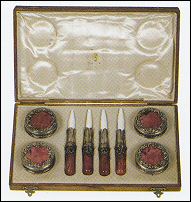
Left: Main Hall Detail – Fabergé Playing Card Score Set by Julius Rappoport
(Photos courtesy Amsterdam Hermitage)
The State Hermitage Museum St. Petersburg
In 2014, The State Hermitage Museum anticipates celebrating the 250th anniversary of its founding with the transformation of the East Wing of the General Staff Building – allocated to them by the Russian government – into a museum for 19th – 20th century art complete with a Fabergé gallery and research library.
The Link of Times Collection
The exhibition, The Age of Fabergé (Эпоха Фаберже) in the Museum of Private Collections, a wing of Moscow’s Pushkin Museum of Fine Arts in Moscow, with loans from the Vekselberg Link of Times Collection has been extended to August 8, 2009. The former Forbes Magazine Collection was acquired by Mr. Viktor Vekselberg in 2004 prior to its scheduled spring auction, and has grown to some 300 objects. Especially noteworthy in the venue, besides the well-known Fabergé eggs, are:
Frames, table decorations, cigarette cases from the Lily and Edmond Safra Collection (Sotheby’s New York, November 3, 2005),
Dancing muzhik (peasant) – one of the best hardstone figures by Fabergé, and more than 20 buckles with fantastic enamel. (Information courtesy of Irina Polynina)

Photographs of the Opening Event with Patriarch Cyril and Mr. Viktor Vekselberg
(Courtesy of Ms. Muntian)

Fabergé Masterpieces from
the “Link of Times” Collection
He does not intend to give his collection to the state, ‘because I personally can share this collection with people … in the format in which I am interested’, and can professionally curate, gather, and restore it. ‘I believe that I have this function, and – then my heirs.’
(Our thanks to David Moore, Salmon Library, University of Alabama in Huntsville, for locating the Russian text of the interview.)
Fabergé Museum
On May 9, 2009, Alexander Ivanov of Moscow, successful bidder of the 1902 Rothschild Clock by Fabergé for $16.5 million, opened a museum in the resort town of Baden-Baden, Germany. The Moscow Times, April 6, 2009, reports a 19th century four-story building to house the museum was acquired and renovated by Mr. Ivanov. It includes a €1 million security system.

Rothschild Clock from
Rheims, L’óbjet 1900,
1964, no.29
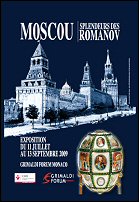
Monaco Grimaldi Forum
Moscow: Splendours of the
Romanovs
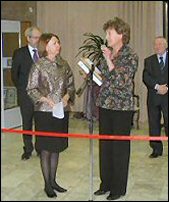
National Library of Russia
Homage to Carl Fabergé: Books –
Design Studies – Photographs
July 11 – September 13, 2009 Grimaldi Monaco Forum – Cultural Center
Moscow: Splendours of the Romanovs
Exhibition presents objects from three centuries of Romanov rule with special emphasis on Russian art from the mid-18th century to the early 20th century. Fabergé eggs from the Vekselberg Link of Times Collection, and the Blue Serpent Clock Egg from the Collection of the Prince’s Palace of Monaco are on view. Catalog available in September 2009.
National Library of Russia
Digital photos from the successful Homage to Carl Fabergé: Books – Design Studies – Photographs venue are available online. Shown in the photo above at the ribbon cutting are Irina Lynden, Deputy Director for International Affairs of the National Library of Russia in St. Petersburg, and Ulla Tillander-Godenhielm, lender to the exhibition.
Pratt Collection
The Fabergé Gallery of the Virginia Museum of Fine Arts in Richmond is closed until May 1, 2010.
Russian State Historical Archive (RGIA) was located until 2006 in one of the most beautiful buildings in St. Petersburg designed by architect Karl Rossi (1775-1849). In May 2008, after an extensive restoration, the Constitutional Court of the Russian Federation moved into this space. The RGIA, after a three-year building project, opened in new modern quarters and houses nearly 220 km of document shelving, and welcomes art history researchers. The new address is Zanevsky prospect, 36, St. Petersburg 195112. (Courtesy of Galina Korneva)

Grand Hotel Europe St. Petersburg
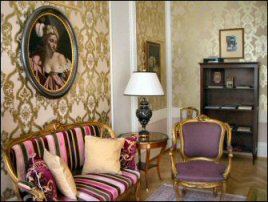
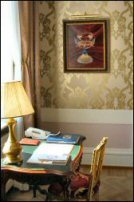
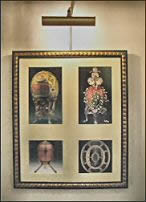
The Fabergé Suite – Photos © Paul Kulikovsky
Nicholas II: The Broken Triumph, a documentary full of praise for the Tsar was shown on Russian National Television and is now available on the internet in Russian. (Courtesy Paul Kulikovsky)
Royal Russia Videos
Historical and contemporary film footage of the Romanov dynasty is featured monthly by Gilbert’s Royal Books. (Courtesy of Jerzy Kalasznikow)
Russian Books and Periodicals
Panorama of Russia imports Russian reference, academic books and periodicals. The 20,000 titles in stock are searchable in English and Russian (Note: Searching in Cyrillic font is case-sensitive) on their website. In celebration of 20 years of service, they are offering USA website customers free media rate shipping for the rest of the year.
catalogue raisonné for the Objects of Desire: Fabergé from the Hodges Family Collection is now available from the New Orleans Museum of Art. Color images with accompanying text for each object in the collection are supplemented by the following essays: Discovering Historical Connections by Dr. Daniel L. Hodges as told to Christel L. McCanless, Carl Fabergé and Russian Money by Dr. Géza von Habsburg, Fabergé’s Work in Wood by Kieran McCarthy, and Fabergé and His Oeuvre by John W. Keefe.
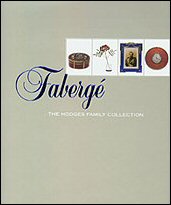
Fabergé: The Hodges Family
Collection
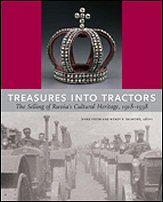
Treasures into Tractors
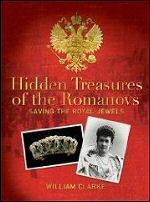
Hidden Treasures of the
Romanovs
Following extensive research in St Petersburg, Moscow and Paris, William Clarke in his new book, Hidden Treasures of the Romanovs: Saving the Royal Jewels, reveals for the first time the story of Albert Henry Stopford, Edwardian man-about-town, member of the English aristocracy, dealer in objects d’art from Fabergé and Cartier, and a regular guest at Romanov dinner tables. In the terrible turmoil of the Russian revolution he risked his life, rescuing Romanov jewels from the Vladimir Palace worth millions of pounds from under Bolshevik noses, and taking back to Britain in his Gladstone bag gems that were destined to adorn the rich and famous. Ninety years later, as an intriguing postscript to this extraordinary story, the author unearthed an unclaimed Romanov bank account in London in the name of Grand Duke Andre; it has now been claimed by more than a score of his heirs.
Ulla Tillander-Godenhielm’s response to this question: A list of the names for all known members of the Fabergé family according to their birth certificates is in Fabergé ja hänen suomalaiset mestarinsa (Fabergé and His Finnish Workmasters) 2008, 18-19. It is not unusual for the calling name to come second.
Peter Karl Fabergé was born on May 30, 1848. His Russian mark was ![]() for Karl Fabergé (Карл Фаберже); for the English market it was CF
for Karl Fabergé (Карл Фаберже); for the English market it was CF ![]() . I have always thought it was wrong to say Peter Carl for the same reason that I would find it strange, if you called me Edith Ulla. Bainbridge was almost a poet – his text is ‘music’ and Peter Carl somehow sounded better to him than the prosaic Karl.
. I have always thought it was wrong to say Peter Carl for the same reason that I would find it strange, if you called me Edith Ulla. Bainbridge was almost a poet – his text is ‘music’ and Peter Carl somehow sounded better to him than the prosaic Karl.
Ulla Tillander-Godenhielm further suggests the names of the Finnish Fabergé workmasters (Ibid., 404-5) be cited as their names are spelled on their birth certificates, with the understanding that the birth certificate lists all given names of the person. Only the names the workmasters themselves used in their marks should be cited with Fabergé objects. Thus, the workmaster Armfelt often misspelled Karl Armfeldt should be Hjalmar Armfelt, Victor Aarne should be Viktor Aarne and Anders Nevalainen should be Antti Nevalainen, etc.
Viktor Aarne (not Victor Aarne) – workmaster marks J.V.A and BA ![]()
Hjalmar Armfelt (not Karl Armfeldt) – workmaster mark ЯА ![]()
August Hollming – workmaster mark A*H ![]()
Väinö Hollming – August’s son, continued using his father’s mark A*H ![]()
August Holmström (not Holstrom or Holmstrom) – workmaster mark AH ![]()
Albert Holmström – The former’s son, continued using his father’s mark AH ![]()
Erik Kollin (not August Erik) – workmaster mark EK ![]()
Anders Mickelsson – workmaster mark AM ![]()
Antti Nevalainen (not Anders Nevalainen) – workmaster marks A N and AN ![]()
Gabriel Nykänen (not Gabriel Niukkanen) – workmaster mark GN ![]()
Hiskias Pendin – His birth certificate says Hesekil Pöntinen, but he never used that name in St. Petersburg. He and his children officially changed the name to Pendin and announced this in the official papers – workmaster mark (?) HP. ![]()
Oscar Pihl – 1860-1897 Senior, Fabergé’s workmaster in Moscow – workmaster mark OP ![]()
Oskar Pihl – (Born in Moscow, first name spelled with “k”) 1890-1959 Junior, the former’s son, trained with his uncle Albert Holmström, worked as a designer at A. Tillander in Helsinki. Neither Oskar nor his sister Alma had marks of their own.
Alma Pihl (not Anna Pihl or Phil) – The former’s sister. Her married name was Alma Klee.
Stefan Väkevä (not Stephan Wäkeva) – workmaster marks S•W ![]() and S.W
and S.W ![]()
Konstantin Väkevä – 1860-1902 Stefan’s older son, brother of Alexander – workmaster mark K.W. ![]()
Alexander Väkevä (not Alexander Wäkeva) – workmaster mark A.W ![]()
Jenny Väkevä – Konstantin’s wife. Having become a widow in 1902, she had the right to mark one part of the Väkevä workshop’s production with her own mark – J.W. ![]()
Henrik Wigström (not Henrik Immanuel) – workmaster mark H.W. ![]()
Preben Ulstrup in Krog, Ole Villumsen, et al. Treasures in Russia – Imperial Gifts (2002, 182-3) cites the existence of a letter, the Dowager Empress wrote to her son Nicholas II on March 28, 1896, from La Turbie in the south of France where she was keeping her ailing son Georgi company. The letter supports the theory that the 12 Monogram Egg is the missing Alexander III portraits Egg, as it is unlikely Fabergé made two successive blue Imperial eggs with the two Imperial monograms:
